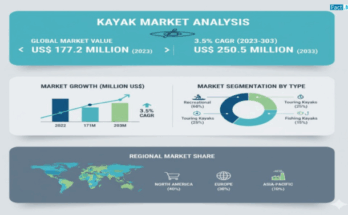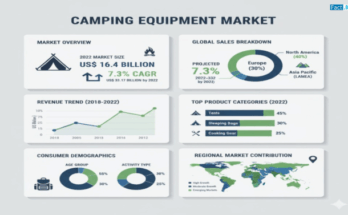Ice skating has evolved from a recreational pastime into a globally recognized sport, blending artistry, athleticism, and precision. The growing popularity of figure skating, ice hockey, and recreational ice skating is driving steady demand for advanced ice skating equipment. Whether it’s performance skates designed for professional athletes or durable gear for beginners, the market continues to expand with innovations in design, safety, and comfort.
The ice skating equipment market is influenced by shifting consumer preferences, lifestyle trends, and advancements in sporting technology. As urban centers invest in ice rinks and winter sports facilities, the demand for equipment continues to rise, making this market a vital segment within the global sports industry.
Market Overview
The market includes a wide range of equipment—ice skates, protective gear, and accessories—that cater to professionals, enthusiasts, and first-time skaters alike. Growing consumer emphasis on high-performance, lightweight, and ergonomically designed products has encouraged manufacturers to integrate advanced materials like carbon fiber composites and memory foam into their offerings.
Moreover, equipment manufacturers are focusing on enhancing safety without compromising performance. Helmets, guards, and padding are becoming increasingly sophisticated to reduce injury risks, especially in ice hockey and high-intensity skating. Alongside this, aesthetic appeal remains important, particularly in figure skating, where both performance and design influence purchasing decisions.
The rise of e-commerce platforms has significantly expanded accessibility, enabling consumers worldwide to purchase quality gear. This shift in distribution channels has also encouraged greater product variety and competitive pricing strategies.
Regional Insights
North America
North America leads the ice skating equipment landscape due to the popularity of ice hockey and figure skating. Professional leagues, college-level competitions, and strong community-level participation support continuous demand. Retailers and brands in this region emphasize innovation and customization, providing athletes with gear that matches performance requirements.
Europe
Europe holds a strong presence, with ice skating deeply rooted in its cultural and sporting traditions. Countries such as Russia, Sweden, and Finland are major markets due to their historical ties to ice sports. The popularity of figure skating and the growth of recreational ice rinks across urban centers continue to boost demand.
Asia-Pacific
Asia-Pacific is emerging as a promising market with increasing investment in winter sports infrastructure. Rising enthusiasm in countries like China, Japan, and South Korea is fueling awareness and participation in ice skating. This region is also witnessing growth in youth engagement, with governments and sports organizations promoting ice sports as part of athletic development programs.
Middle East & Africa
Although ice skating is relatively niche in this region, the development of indoor ice rinks in cities like Dubai and other metropolitan hubs is opening opportunities. Tourism-driven demand, especially in luxury recreational centers, contributes to market expansion.
Latin America
Latin America represents a smaller but growing segment, with indoor skating arenas fostering interest in ice sports. Increasing exposure to global sporting events and international competitions is gradually boosting demand for quality skating gear in countries like Brazil and Argentina.
Key Trends & Forecast
- Material Innovation
The use of advanced materials such as lightweight alloys, carbon fiber, and memory foam is redefining comfort and performance. These innovations enable enhanced durability while reducing fatigue during prolonged activity. - Customization and Personalization
Athletes and enthusiasts alike seek equipment that aligns with personal preferences. Skates with adjustable features, customizable blades, and personalized fits are increasingly popular. - E-Commerce and Digitalization
Online retail platforms are revolutionizing how equipment is purchased, providing access to a wide variety of brands and models. Virtual fitting tools and AI-driven product recommendations are enhancing the digital shopping experience. - Sustainability in Production
Eco-friendly production processes and recyclable materials are gaining importance. Consumers are more conscious of sustainability, influencing brands to adopt greener manufacturing and packaging practices. - Youth Engagement
With more schools and clubs encouraging participation in ice sports, the demand for beginner-friendly and affordable equipment is on the rise. Brands are developing entry-level gear that balances safety, comfort, and cost. - Professional Sports Influence
Major sporting events like the Winter Olympics and international ice hockey championships create surges in equipment demand. Endorsements by professional athletes further shape consumer preferences and market trends.
Applications & End-Use Outlook
The ice skating equipment market is segmented based on different applications and end-user profiles:
- Figure Skating
A discipline blending sport and artistry, figure skating demands lightweight skates with exceptional precision and control. Aesthetic design also plays a crucial role in equipment selection. - Ice Hockey
Known for its intensity and physicality, ice hockey requires robust skates, helmets, guards, and padding. Protective gear is a central focus in this segment due to the sport’s high-impact nature. - Recreational Skating
Recreational skaters represent a significant consumer base, seeking comfort and durability over advanced performance. Affordable and entry-level products are especially relevant here. - Speed Skating
Speed skaters rely on highly specialized skates with aerodynamic designs and sharp blades for maximum velocity. This niche segment highlights performance-driven innovation. - Youth and Amateur Skating
Youth participation is a growing area, with equipment designed for safety, adaptability, and cost-effectiveness. Skates with adjustable sizes are particularly popular among younger users.
Conclusion
The ice skating equipment market is gliding steadily toward innovation, driven by advancements in design, materials, and consumer engagement. From professional athletes to recreational participants, the need for safe, comfortable, and performance-oriented gear is shaping future developments.
Regional markets are evolving at different paces—North America thrives on professional leagues, Europe leverages its deep sporting traditions, Asia-Pacific accelerates through infrastructure development, while emerging regions like the Middle East and Latin America focus on tourism and recreational centers.
Key trends such as sustainability, digital retail, and personalization will further define the market’s trajectory. With growing youth participation and the influence of global sporting events, the industry is set to witness continuous transformation.
Ultimately, ice skating equipment is more than just gear—it represents an intersection of technology, safety, artistry, and culture. Companies that align with consumer demands while embracing innovation and sustainability will remain at the forefront of this expanding market.



